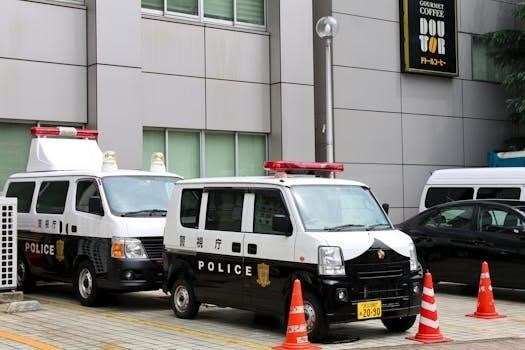Safety Precautions
Always ensure the portable air conditioner is connected to a properly grounded electrical outlet to prevent electric shock. Inspect the cord regularly.
Electrical Safety
Before installing or operating the portable air conditioner, carefully inspect the power cord and plug for any signs of damage. A damaged cord or plug can pose a serious electrical hazard. Ensure that the outlet you intend to use is properly grounded and capable of handling the air conditioner’s power requirements. Never use extension cords or adapters, as they can overload the circuit and create a fire risk. If an extension cord is absolutely necessary, use a heavy-duty cord rated for the air conditioner’s amperage. Keep the power cord away from water and heat sources. Do not attempt to repair a damaged power cord yourself; contact a qualified electrician for assistance. Always unplug the air conditioner before cleaning or performing any maintenance. If you notice any unusual smells, sounds, or smoke coming from the unit, immediately unplug it and contact a service technician. Regularly check the power cord and plug for wear and tear. Consider using a surge protector to protect the air conditioner from power surges. Read the manual carefully.
General Safety Guidelines
Prior to using the portable air conditioner, thoroughly read and understand the instruction manual. This will provide crucial information regarding safe operation and maintenance. Always place the air conditioner on a stable, level surface to prevent it from tipping over. Ensure that the unit has adequate ventilation by keeping the air intake and exhaust vents clear of obstructions. Do not block the airflow with curtains, furniture, or other objects. Never insert fingers or objects into the air vents, as this could cause injury or damage to the unit. When moving the air conditioner, always unplug it from the power outlet and lift it carefully. Avoid dropping or bumping the unit, as this could damage internal components. Do not use the air conditioner in wet or damp environments, such as bathrooms or laundry rooms. Keep the air conditioner away from flammable materials, such as gasoline or propane. Supervise children and pets when the air conditioner is in use. Never allow them to play with or around the unit. Store the air conditioner in a dry, safe place when not in use. Do not attempt to disassemble or modify the air conditioner yourself. Contact a qualified technician for repairs.

Initial Setup and Installation
Before installation, verify all components are present⁚ unit, exhaust hose, window kit, and manual. Contact support if anything is missing.
Checking Components and Accessories
Prior to commencing the installation of your portable air conditioner, it is imperative to meticulously inspect the contents of the packaging to ensure that all essential components and accessories are accounted for. This diligent verification process will prevent potential delays and ensure a seamless setup experience. Begin by confirming the presence of the primary unit, which houses the core cooling mechanisms. Subsequently, locate the exhaust hose, a crucial element for venting hot air outside. The window kit, designed to facilitate secure and efficient hose placement within a window frame, should also be present. Finally, verify that the instruction manual, containing vital safety guidelines, operational instructions, and troubleshooting tips, is included. Should any component or accessory be absent or damaged, refrain from proceeding with the installation and promptly contact the manufacturer’s customer support or the retailer from which the unit was purchased. Providing them with the model number and a detailed description of the missing or damaged item will expedite the resolution process. Neglecting this initial check could lead to operational difficulties or compromise the unit’s performance. Remember, a complete set of components is fundamental for optimal functionality and longevity.
Connecting to Power Supply
Before connecting your portable air conditioner to a power source, it is paramount to ensure that the voltage and frequency of your electrical supply precisely match the specifications outlined on the unit’s rating label. This label is typically located on the back or side of the air conditioner. Using an incompatible power supply can lead to severe damage to the unit, void the warranty, and potentially create a fire hazard. Prior to plugging in the unit, carefully inspect the power cord and plug for any signs of damage, such as fraying, cracks, or exposed wires. If any damage is detected, do not use the air conditioner and contact a qualified electrician for repair or replacement. Ensure that the power outlet you intend to use is properly grounded and capable of handling the electrical load required by the air conditioner. Avoid using extension cords or power strips whenever possible, as they can overheat and pose a safety risk. If an extension cord is absolutely necessary, use a heavy-duty cord that is rated for the air conditioner’s amperage. Once you have verified the compatibility of the power supply and inspected the power cord and outlet, plug the air conditioner directly into the grounded outlet. Avoid overloading the circuit by plugging multiple high-power appliances into the same outlet. After connecting the unit, monitor it for any unusual noises, smells, or performance issues. If you observe any irregularities, immediately disconnect the power and consult the troubleshooting section of the instruction manual or contact a qualified technician for assistance. Adhering to these guidelines will ensure safe and reliable operation of your portable air conditioner.

Operating Modes and Functions
This section details the various operating modes, such as cooling, dehumidifying, and fan, and their respective functions.
Cooling, Dehumidifying, and Ventilating Modes
The portable air conditioner offers three primary operating modes to cater to various environmental needs. Cooling Mode⁚ In this mode, the unit actively cools the surrounding air by circulating refrigerant and expelling warm air through the exhaust hose. The temperature can be adjusted to a desired level using the control panel or remote control. Ensure the exhaust hose is properly installed to vent the hot air outside for optimal cooling performance. Dehumidifying Mode⁚ This mode focuses on removing excess moisture from the air, making it ideal for damp or humid environments. The air conditioner extracts moisture, which is then collected in an internal tank or continuously drained through a hose. While dehumidifying, the unit may also provide a slight cooling effect. Ventilating Mode⁚ Also known as fan mode, this setting circulates air within the room without actively cooling or dehumidifying. It’s suitable for creating a gentle breeze and improving air circulation. The fan speed can usually be adjusted to different levels, such as low, medium, or high, depending on the desired airflow. This mode consumes less energy compared to the cooling mode.
Control Panel and Remote Control Functions
The portable air conditioner is equipped with a user-friendly control panel and a convenient remote control for easy operation. Control Panel Functions⁚ The control panel typically features buttons or a touchscreen interface for adjusting various settings. Common functions include⁚ Power Button⁚ Turns the air conditioner on or off. Mode Button⁚ Selects the operating mode (cooling, dehumidifying, or ventilating). Temperature Adjustment Buttons⁚ Increases or decreases the desired temperature in cooling mode. Fan Speed Button⁚ Adjusts the fan speed in cooling and ventilating modes. Timer Button⁚ Sets a timer for the air conditioner to automatically turn on or off after a specified duration. Display Screen⁚ Shows the current temperature setting, operating mode, and timer settings. Remote Control Functions⁚ The remote control replicates most of the control panel functions, allowing you to adjust settings from a distance. It often includes additional features such as⁚ Sleep Mode⁚ Gradually increases the temperature setting during the night for comfortable sleep. Swing Button⁚ Activates the louver swing function, which evenly distributes airflow. Turbo Mode⁚ Operates the air conditioner at maximum cooling power for rapid temperature reduction.

Maintenance and Cleaning
Regular filter cleaning is essential for maintaining optimal performance. Turn off and unplug the unit before removing and cleaning the filter.
Filter Cleaning Procedures
To ensure optimal performance and longevity of your portable air conditioner, regular filter cleaning is crucial. Dust and debris accumulation on the filter can significantly reduce cooling efficiency and increase energy consumption. Before commencing any cleaning procedures, always turn off the unit and unplug it from the power outlet to prevent electrical hazards. Locate the filter access panel, usually situated at the back or side of the unit, and carefully remove the filter. Depending on the model, the filter may be a washable type or require replacement. For washable filters, gently rinse them with lukewarm water, avoiding the use of harsh detergents or abrasive cleaners. Allow the filter to air dry completely before reinstalling it into the unit. If the filter is disposable, replace it with a new one of the correct size and type. It is recommended to clean or replace the filter every two weeks during periods of frequent use, or more often if the environment is particularly dusty. Neglecting filter maintenance can lead to reduced airflow, decreased cooling capacity, and potential damage to the air conditioner’s internal components. Proper filter cleaning not only enhances the unit’s performance but also contributes to improved indoor air quality by removing allergens and pollutants from the air.
Storage Instructions
Proper storage of your portable air conditioner during periods of non-use, such as the off-season, is essential to prevent damage and ensure its optimal performance when you need it again. Before storing the unit, it is crucial to drain any remaining water from the water tank or reservoir to prevent the growth of mold and mildew. Remove the drain plug or use the drainage hose to completely empty the tank. Allow the unit to run in fan-only mode for several hours to thoroughly dry the internal components. Clean the air filter and ensure it is completely dry before reinstalling it. Disconnect the exhaust hose and window kit and store them separately to prevent damage. Coil the power cord neatly and secure it with a cable tie or Velcro strap to avoid tangling. Store the portable air conditioner in a cool, dry place, away from direct sunlight, extreme temperatures, and excessive humidity. Cover the unit with a dust cover or plastic sheet to protect it from dust and debris. Avoid storing the unit on its side or upside down, as this can damage the internal components. When storing the window kit, ensure all parts are kept together to avoid misplacement. Periodically inspect the stored unit to ensure it remains in good condition. By following these storage instructions, you can prolong the life of your portable air conditioner and ensure it is ready for use when the warmer weather returns.

Troubleshooting
Experiencing problems? Check the power cord, filter, and exhaust hose first. Consult the manual for specific troubleshooting steps.
Common Issues and Solutions
Problem⁚ Unit not turning on. Solution⁚ Verify the power cord is securely plugged into a functioning outlet. Check the circuit breaker or fuse box to ensure there’s no tripped breaker or blown fuse. If using an extension cord, confirm it’s suitable for the air conditioner’s power requirements. Problem⁚ Poor cooling performance. Solution⁚ Ensure the air filter is clean, as a dirty filter restricts airflow. Check the exhaust hose for kinks or obstructions that could impede hot air removal. Make sure the room is adequately sealed to prevent warm air from entering. Problem⁚ Water leakage; Solution⁚ Check the drain plug or hose for proper installation and drainage. Empty the water tank if it’s full. Ensure the unit is placed on a level surface to facilitate drainage. Problem⁚ Unusual noise. Solution⁚ Inspect the unit for loose parts or debris. Contact customer support if the noise persists after inspection. Problem⁚ Remote control not working. Solution⁚ Replace the batteries in the remote. Ensure there’s a clear line of sight between the remote and the air conditioner. If the problem persists, consult the user manual or contact customer support.






